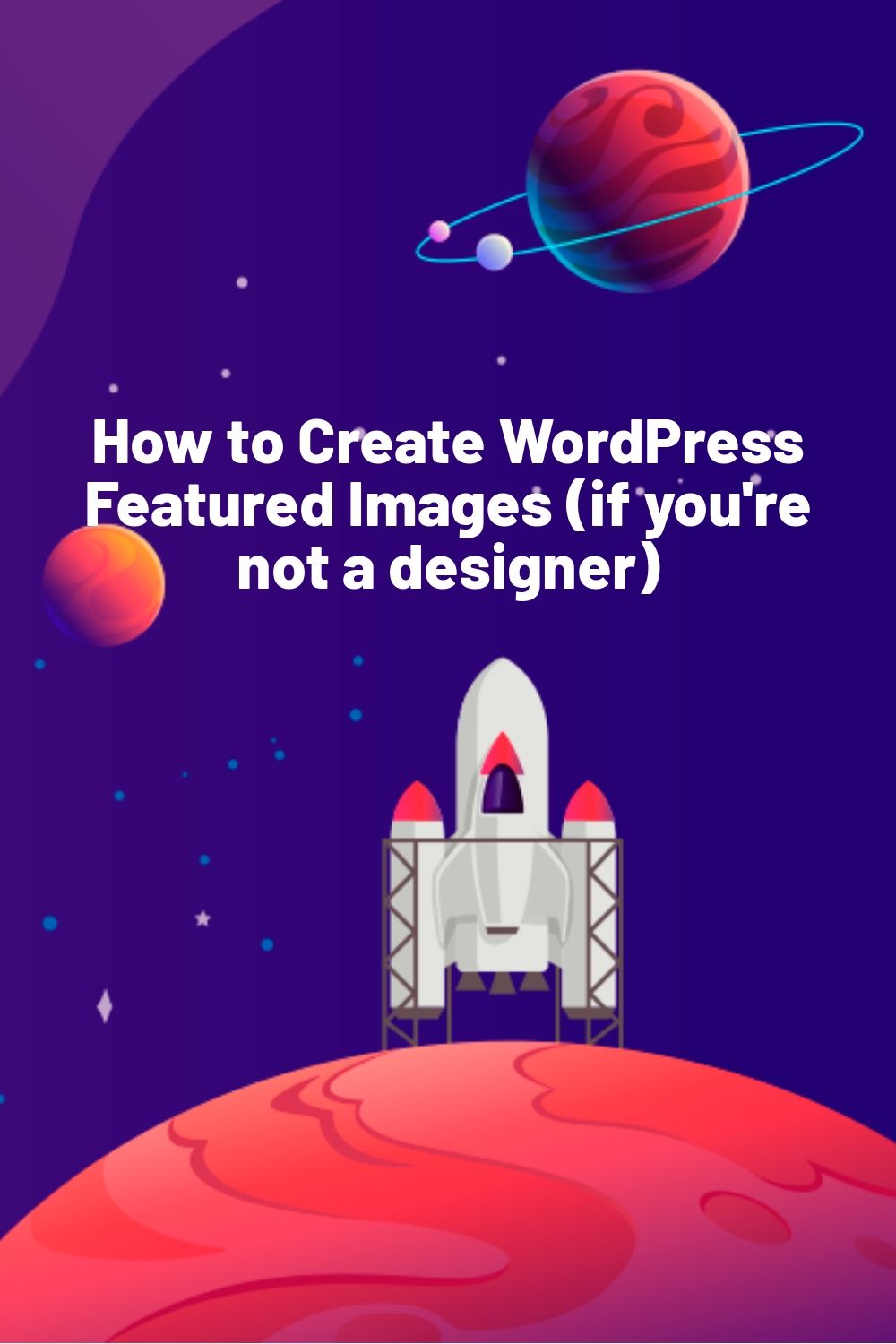WPLift is supported by its audience. When you purchase through links on our site, we may earn an affiliate commission.
How to Create WordPress Featured Images (if you’re not a designer)
I’m going to let you in on one of my deep, dark secrets:
I’m a horrible designer. As someone who’s known for his spartan home decorating and fondness for white walls, calling me merely “design challenged” would be a compliment.
But, because I know how important images are to blog posts, I try anyway.
So, when I tell you that I, the most design challenged person you’ll ever meet, have still found a simple way to create beautiful featured images for WordPress…well, you should probably listen.
In this post, I’m going to show you how to use Canva to create beautiful featured images for your WordPress posts. You can also use it to create images to share your post on Twitter or Facebook, or for any other image editing you need.
Canva is easy to use, even if you’ve got no design chops. And once you get the process down, you can create well-designed images surprisingly quickly.
So, without further self-deprecation of my design skills, let’s dig into how to use Canva to create top-notch WordPress featured images.
What is Canva?
Canva is a cloud-based design tool. Think of it as Photoshop for dummies. It takes those cool effects people with actual design talent create and boils them down to a simple drag and drop interface that anyone can use.
It’s not just for blog images – you can also use it to create presentations, infographics, social media images, and more.
You can use any one of a number of pre-built templates or create your own design from scratch.

Article Continues Below
For this post, I’ll be showing you how to do the latter. I’ll go through exactly how to create a custom image with the exact dimensions for your specific WordPress theme.
Step 1: Create a Canva image with custom dimensions
Once you’ve signed up for a Canva account, you need to create an image with the exact dimensions for your blog theme. Canva hides this feature a bit – but just look at the top right corner and click the button:

Step 2: Pick a background image
You can always use a solid color background. But, I think that’s a little boring. Instead, it’s usually better to pick a stock photo. You can pay for a stock photo if you want, but there are plenty of resources to find free, high-quality images. Here are some of my favorites:
- Unsplash – Unsplash is my absolute favorite. They provide beautiful high-resolution photos that make perfect backgrounds. Everything is high quality. But, they don’t offer a huge selection. So if you need something specific, it can be hard to find.
- Pixabay – Pixabay lets you search over 670,000 free images. Unlike Unsplash, you’ll have to dig through lots of low-quality images to find what you want. But, it also has a much more variety and is searchable,
- Canva – Canva includes their own image search. I don’t think it’s as good as the previous two, but it is the easiest way to add images to your Canva design. Also, a lot of the images on Canva will cost $1.00 – the free selection is limited.
- Biteable Image Resizer – Biteable’s new image resizer tool is completely free and no need to create an account! just upload your file there and select the desired size for your image. Plus a handy tool to instantly resize your image to 50+ different sizes for social media.
Go to one of the sites and pick the image you want. If you use Unsplash or Pixabay, you’ll need to download the image and then upload it to Canva.
For this example, I’ll use this beautiful picture from Unsplash:

And then I’ll upload it to Canva:

Once you’ve uploaded it, just drag it over to your canvas. Because the dimensions might not match, Canva will automatically crop it to fit your canvas. Just move it around until you get the perfect crop.
Step 3: Style your background image
Because you want people to actually be able to read the text on your featured image, you’ll need to do a little styling on your background image.
To make the text pop, there are two ways I like to style background images:
- Transparent color overlays
- Filters that darken the image
Here’s what a color overlay looks like on the background image I chose:

To add a color overlay, you need to add a square shape that fits the exact dimensions of your image. You can add the square shape by going to “Elements” → “Shapes”. Drag the square over and then resize it to fit your full canvas.
Then, once you’ve added that shape, pick whatever color you want and make it transparent by clicking on the down arrow:

Another option is to embrace your inner Instagram and apply a filter to your image. To do that, click on your background image and choose the filter option. You can choose from one of Canva’s preset filters or make your own:

Step 4: Add your text
Now that I’ve created a suitable background, it’s time to add some text.
Canva includes boatloads of custom options, but it can also be fun to play around with their fonts by yourself:

If you can edit text in Word, you should be able to handle editing text in Canva. After a little playing around, here’s what I came up with (see how much I like white?):

Note – if your theme automatically overlays text over your featured images (like WPLift’s does), you may not even need to add your own text.
Step 5: Add elements (if desired)
Canva has plenty of other elements you can add to spice up your designs. You can browse their pre-made list or easily search for a specific element. Not every element will be free, but Canva is always up-front if it costs money. Even the paid elements usually only cost $1.00.
I searched around and found the WordPress logo as a free element. Hmmm – wouldn’t that be great to add? Let’s do it:

You can also add elements like stylized underlining to spice up your image. But, I’m a minimalist, so I’m gonna skip that.
Step 6: Download and post
Once you’re happy with the elements you’ve added, you’re ready to download your featured image and share it on your WordPress site. To do that, just click “Download” in the top right and choose your desired format:

Canva will give you a .zip file containing your design. You can then upload it directly to WordPress to set as your featured image.
Result
So, after going through the process above, here’s my final product:
It took me less than 10 minutes and it looks surprisingly professional.
Once you get the hang of Canva, you should be able to churn out images just as quickly. They’re a great way to boost the professionalism of your blog and make it easy for readers to share an image with your post when they share on Twitter or Facebook.
Your turn:
Do you have any suggestions for free image sources? Use another tool to create images? Want to say mean things about my design skills? Let me know in the comments.











Top post thanks. Never heard of Canva before will certainly look at this and will recommend it to my clients as a tool. I usually recommend https://pixlr.com/editor which is a free online image editor / creator much like Photoshop but still commands some knowledge to use.
Thanks! I like Canva because of how easy it is to use. I checked out Pixlr and it looks like it will give you more control, but at the expense of a much higher learning curve.
One more great tool to share with your clients: https://designfeed.io/
It’s for social media, but a great tool to produce social media images with!
Thanks for sharing informative post Colin. Mostly I am using https://pixlr.com tool. It’s really great tool for blogger.
Thanks for sharing, Jigar! That’s two votes for Pixlr now. I’ll definitely need to check it out in some more detail
Thank you!!! very useful!
Awesome Colin, thanks for sharing!
Pat
Nice one – thanks for sharing
Awesome post. I actually wrote about a similar subject a while back so I know what you went through trying to create a featured image: https://blog.pojo.me/featured-images/
Thanks for sharing, Ben. The list of category-specific photo sites is definitely helpful!
Thank you so much we will be share it useful post i will be clearly that the wonderful post.it’s a great blog
Canva is the best for non designer bloggers it’s so simple and easy to use and if u upgrade for 12 $ it will gives you many useful options like image resizer.